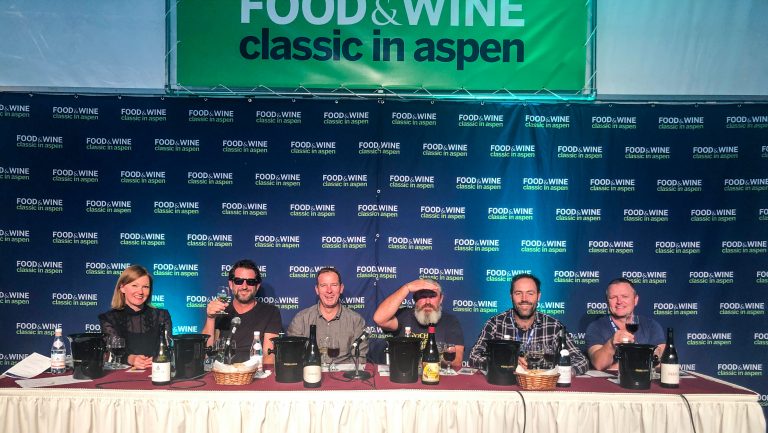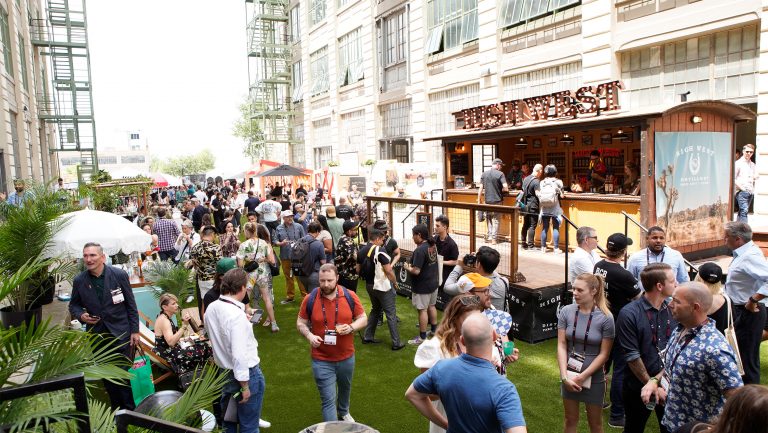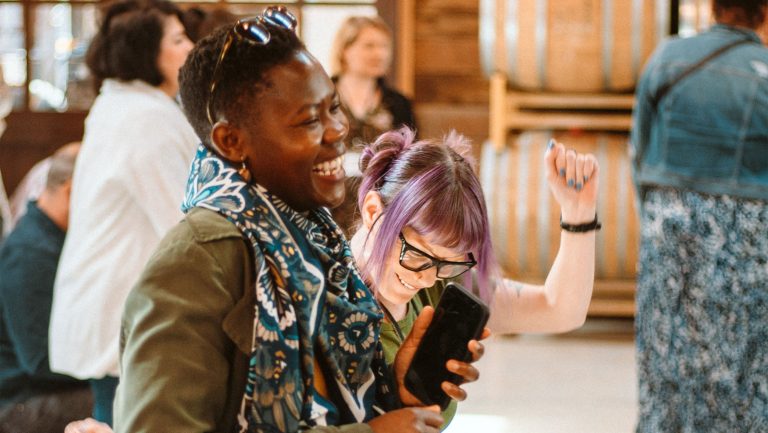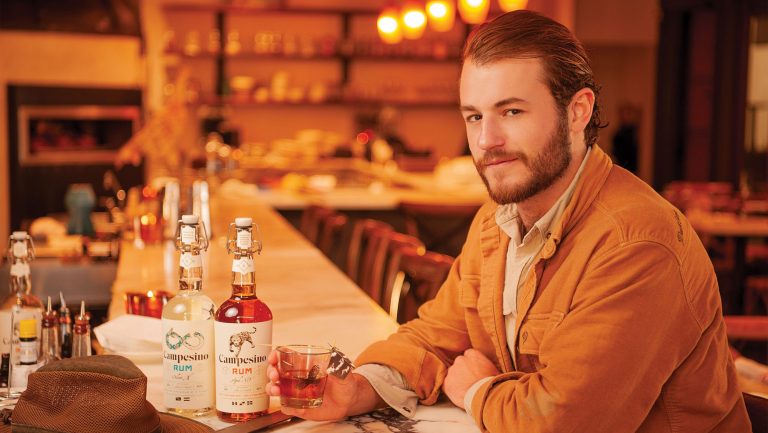A panel titled New Wave South African Wines at the Food & Wine Classic, held from June 13 to 16 in Aspen, Colorado, drew a crowd that was eager to learn about the strides South African wine has made in recent years. From advances in farming, with a focus on variety- and site-specific qualities, to an open national dialogue about grape growing and winemaking, to viticultural experiments planning for a future shaped by climate change—South Africa’s new wave is led by quality.
Moderated by Kelli White, a senior staff writer for GuildSomm and the author of Napa Valley Then & Now, the panel consisted of five South African winemakers: Sebastian Beaumont of Beaumont Family Wines in the Overberg district; Graham Weerts of Capensis, which makes wines throughout the Western Cape; Adi Badenhorst of A.A. Badenhorst Family Wines in Swartland; Eben Sadie of Sadie Family Wines in Swartland; and Abrie Beeslaar of Beeslaar and Kanonkop Estate in Stellenbosch. White herself admitted to dismissing the country’s wines until a recent trip to South Africa. “I’m sorry to say,” she said, “that I spent 20 years of my life ignoring these wines.” White is now a convert who proclaims the “freshness and purity” of the wines coming out of this New World [wine] country.
Positive Competition Brings Great Results
Though the modern age of South African winemaking began with vineyards planted in 1655, the country’s wine industry was hindered throughout much of the 20th century. In the past 25 years, South Africa has undergone a revolution in quality, an upward trajectory that most winemakers attribute to the industry’s open dialogue about farming and producing, marketing, and selling wines. According to WOSA, 40 percent of vineyards have been replanted in recent years, and more white varieties are being planted than ever before.

Don’t miss the latest drinks industry news and insights. Sign up for our award-winning newsletters and get insider intel, resources, and trends delivered to your inbox every week.
Both Badenhorst and Sadie pointed to 1994 as the year these changes began, in a postapartheid South Africa. “There’s a countrywide dialogue going on at a national level [about wine],” said Badenhorst. “Today, we have a very open community, and there’s no smoke and mirrors.”
“Competition is good because a rising tide raises all boats,” said Sadie. “South Africa is a real wine country, not a pseudo-wine country.” As evidence of this sentiment, the panelists presented five wines that represented the upper echelon of South African wine, with retail prices ranging from $38 to $120.
The Beaumont Hope Marguerite Chenin Blanc 2018 from Bot River, which retails for around $38, showcased the potential of the country’s signature white grape variety with its brightness and vivacity, as described by Beaumont. Attendees also had the opportunity to try a high-end version of another South African staple: Pinotage. Though the grape often gets a bad rap, the Beeslaar Pinotage 2016 from Stellenbosch, which retails for around $45, turned heads with its richness and opulence.
Weerts represents a generation of South African winemakers who have traveled the world to hone their skills before returning to their home country to make wine. Though Weerts also works with several other wineries in the Jackson Family Wines portfolio, he uses vineyards throughout the Western Cape to make wines for Capensis—Latin for “from the Cape.” The Capensis Chardonnay 2015, which sells for $70 at retail, balances toasty oak with intense citrus.
Many of the country’s winemakers are seeking out and highlighting old-vine fruit, which can be found in pockets around South Africa, as Badenhorst does with the A.A. Badenhorst Ramnasgras Cinsault 2017 from Swartland, which retails for around $48. “We farm a really old vineyard of Cinsault, planted in 1963,” he said, “and that translates into amazing fruit, but with gentle tannins that surround and coat the fruit.” Instead of buying pricey winery equipment—the most expensive equipment he owns is a $40,000 coffee machine—Badenhorst focuses on respecting the grapes themselves.
Sadie also works with Swartland Cinsault fruit for the Sadie Family Columella Red 2016, which sells for around $120, but the grape is interplanted with Syrah, Mourvèdre, Grenache, and Tinta Barocca. Working with eight different vineyards with a wide range of elevations and soils, Sadie blends the fine elements of these varying terroirs to create a harmonious wine.

Social Justice is Sparking Change in South Africa’s Wine Industry
How activist-entrepreneurs are creating new career opportunities for people of color
Looking Forward to South Africa’s Future
The five panelists don’t expect the momentum of South Africa’s new wave to end anytime soon. They are looking forward to continued growth. “We have 750 wineries today,” said Beeslar, up from just a few hundred a decade ago—offering steadily rising quality and the prospect of employing more South Africans in the wine industry in the future.
With that in mind, many winemakers are preparing for global warming, which is already affecting the country’s vineyards. According to Sadie, there has been a communal response, and in a proactive measure, growers have begun experimenting with varieties that have greater resistance to heat and drought. Sadie Family Wines is planting an experimental vineyard with more than a dozen such varieties—for example Assyrtiko, Alicante Bouschet, and Aglianico.
Leaving a better farming legacy for their children is a priority for South African winemakers as they plant with many generations in mind. Badenhorst’s nine-year-old daughter recently asked to taste some wine that he was transferring to barrel. “I was so nervous to reply,” he said. “I finally said yes. And she asked for another taste, and she said, ‘This is amazing. This wine tastes of freedom, and it’s the best you’ve ever made.’”

Dispatch
Sign up for our award-winning newsletter
Don’t miss the latest drinks industry news and insights—delivered to your inbox every week.
Jonathan Cristaldi has written about wine for Food & Wine, Los Angeles Magazine, Liquor.com, First We Feast, Thrillist, Time Out LA, and Psychology Today. He was previously the editor in chief of Wine Access and is currently a contributing editor to The SOMM Journal. A witty, avant-garde educator, he was named a Wine Prophet by Time Out NY. Follow him on Instagram @jcristaldi.







